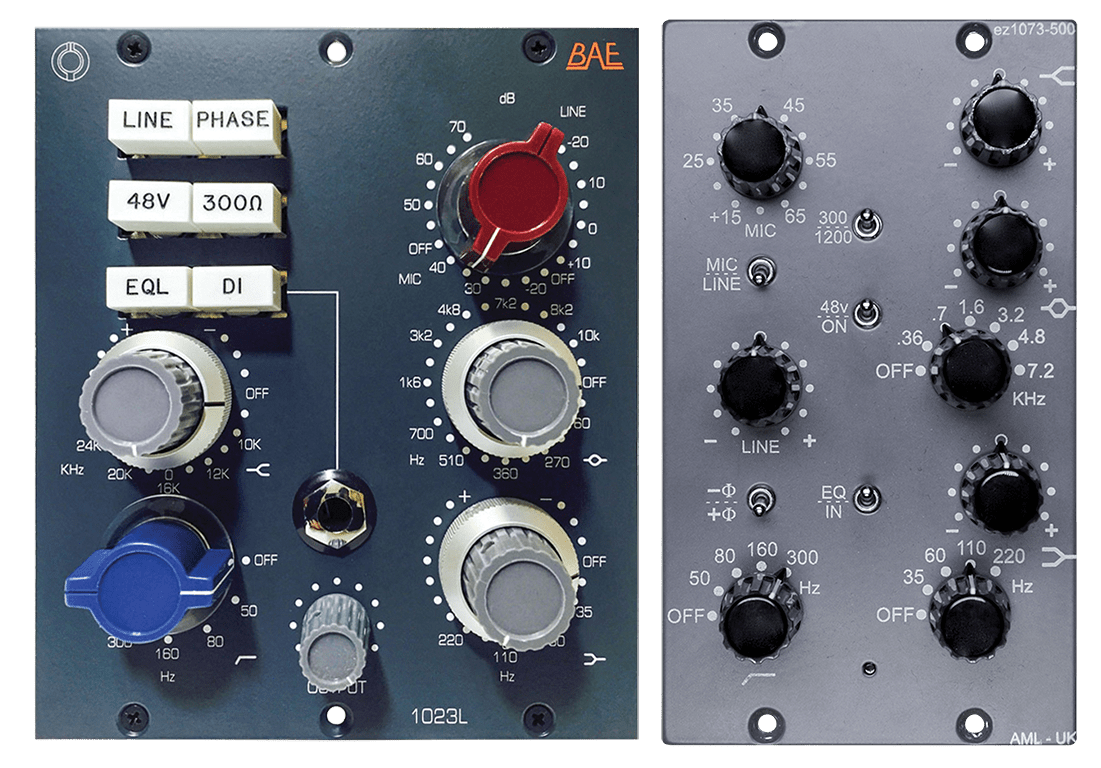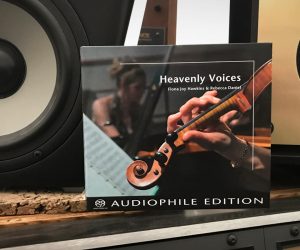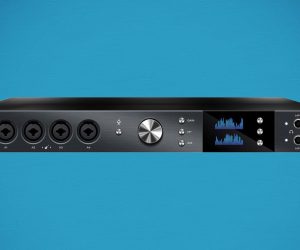
BAE vs AML Neve Clone Shootout
It’s a Class A battle of the transformers as two Neve recreation specialists go head-to-head.
I don’t know about everyone else, but I’m getting a little tired of the extremely tall pedestal that Neve’s vintage recording equipment sits upon these days. I’m not sure whether it’s the online frothing of nerdy engineers and producers, the dewy-eyed look the Neve name elicits from young up-and-comers, or the increasingly obscene asking prices of genuine vintage items offered up on Ebay and Reverb.com. In any case I can’t help feeling like the whole Neve thing is way overblown… and yet every time I track through Neve preamps, mix on a Neve console or run something through a Neve compressor there’s that sound again: the sound of countless great records and doubtless many more great records to come. It’s gluey, thick, musical, undeniably satisfying, even culturally significant, and nothing else out there quite does the same trick. There’s no fighting it! Indeed BAE and AML are two companies (American and British respectively) that wouldn’t dream of putting up any resistance and are delighted to go with the flow and give the people what they want: accurate yet modernised Neve recreations at more attainable prices in everybody’s snack pack favourite, the 500 series format.
DINING OUT
Just to be clear, I’ve got a couple of preamps in my studio built around vintage 1272 Neve cards and I would be very unhappy to lose them, especially given how good they sound on loud electric guitar cabinets. These are, however, merely a pair of bite-sized snacks compared to the five-course banquet of 500 series Neve recreations that arrived from Musos Corner one afternoon in a lovely 10-slot lunchbox. As well as a pair of BAE’s tidy single rack-space 73MPL preamps, BAE’s mighty three-space 1023L preamp/EQ shared centre stage with two large offerings from AML — the ez1073-500 preamp/EQ and the 54F50 compressor/limiter. All these modules share a similar grey palette that gave the whole rack a very military-grade look. There were a lot of knobs begging to be fiddled with and plenty of things that needed recording and mixing in the studio so it was a pleasure to roll up my sleeves and get stuck into a steady diet of Neve for the month or so I had possession of the rack.
NEED TO KNOW

LITTLE BIG
BAE (Once Brent Averill Enterprises, now British Audio Engineering) has been racking and recreating vintage Neve circuits longer than just about anyone else in the game. Their reputation as ‘the next best thing’ to the originals has been earned on the back of consistently excellent build quality, parts sourcing and circuit design. The 73MPL is essentially the preamplifier stage of the Neve 1073 circuit, optimised as a compact 500 series module with a few mod-cons such as DI and impedance switching thrown in. The module utilises original Marconi knobs for the look, and a fully Class A signal path with sought-after Carnhill transformers and point-to-point wiring for the sound. Up to 71dB of gain is available making the preamp capable of driving even very soft ribbon and dynamic microphone sources. The 73MPL can function as a line-level driver and also features a switchable impedance of 1200 or 300Ω to optimise for various microphone sources. The front panel is simplicity itself, with one large stepped rotary control for preamp input and another smaller knob for output control. Between these are the large push-buttons for Hi-Z input, phase reverse and phantom power selection. There’s also a DI input on the front for ease of access. For mine, the output control is the key feature here as you can choose how hard to drive the input (clean at lower levels and thick and dirty at higher levels) while making up or attenuating gain at the output stage. This allows for fine-tuning of the harmonic distortion and larger-than-life bottom end that is a big part of the Neve sound.
Sacrificing compactness in order to deliver comprehensive tonal control is the 1023L – a three module-sized behemoth that again uses the 1073’s preamp section but adds an expanded three-band EQ section plus low cut filter. Compared to the original Neve 1073, the 1023L offers considerably more frequency options in the mid and high bands and also allows for playing with some overlapping frequencies to create new EQ curves. The large faceplate means a spacious layout with large Marconi knobs for all major controls and the classic concentric knob approach to the EQ (the outer ring selects stepped frequencies and band bypass while the inner knob control adds gain clockwise and subtracts it anti-clockwise). The entire EQ circuitry can also be hard-bypassed using one of the sturdy white push-button switches. As with the 73MPL, gain structures are very versatile thanks to the output attenuator. The front panel DI is selectable along with line input, phase reverse, microphone impedance and phantom power. All in all the 1023L is a very imposing unit. Its wide faceplate and large controls certainly proclaim it as a heavyweight in the world of 500 series modules.
EYES ON THE ENTERPRISE
I started my ‘rack of Neves’ banquet with the entrée-sized BAE 73MPL. On a variety of different sources including drums, electric and acoustic guitars, electric bass and vocals the single module unit performed beautifully. The sounds had a strong sense of solidity to them, with great tonal balance and a slight thickening and smoothing to them that helped the tracks sit easily in the mix. I found I needed to take care with this module not to overdo the input gain on loud sources as the sound could blow out quite easily, but it was no problem to adjust input and output levels to get just the required amount of thickening and juiciness out of this box. The 73MPL delivers very pleasing Neve-ish tonalities from clean to dirty and everything in between. The DI also sounds great on bass and synthesizers and I found myself using this feature quite a bit with great results.
Moving over to its big brother the 1023L, it was a joy to augment the BAE mic preamp sound with some sweet analogue EQ. I was able to capture larger than life kick drums, electric guitars and vocals using various combinations of the EQ bands and the high-pass filter to really shape the sounds. The bottom end of this module packs some real power while the mids give great ‘voicing’ options and the top end is super sweet and musical. If there’s one thing the 1023L excels at it is delivering a sense of real power. In addition to the muscular quality of the preamp sound itself, the EQ can be used to great effect, boosting the low mids and cutting frequencies below to really pump up the perceived weight of instruments like electric guitars, drums and keyboards. The BAE 1023L really impressed me as a Neve reproduction that ticked all the boxes in terms of sound and flexibility.
Hitting the limiter harder on the Fast (5ms) setting delivers more extreme results including classic Beatles-style cymbal explosions, thick-as-gravy guitars and monolithic walls of bass
HIGH MAINTENANCE
AML (Audio Maintenance Limited) is a more recently established company with a history of supplying parts and high-grade kits for the DIY community. Its kits, as well as more recent forays into fully assembled modules, have met with great success and the word on the street is its Neve recreations are exceptionally good value for money. The AML ez1073-500, its take on the Neve 1073, is a two rack-space module with full preamp and EQ functionality built and tested in England. The ez1073 shares many of the same features as BAE’s 1023L; Carnhill transformers, impedance switching and a fully Class A hand-wired build. The three EQ bands and high-pass filter can be independently bypassed and there’s a global EQ bypass as well. AML has approached the faceplate layout differently by using smaller, separate rotary pots to select EQ frequencies and to boost/cut them. There are also separate input gain controls for mic and line sources and small silver toggle switches for all selectable features including phase reverse, phantom power and impedance selection.
There are a few differences from the BAE 1023L worth noting. Maximum microphone amplification is slightly lower at +65dB and there is no output attenuation, meaning if you want to drive the ez1073’s input hard you will need to patch it into another device in order to damp down the output level (the CAPI Missing Link is a popular choice for this). The six midrange frequencies and fixed high-band EQ are faithful to the original 1073 in a way the expanded tonal options of the 1023L are not. The AML’s build quality and ergonomics are similarly excellent. The unit is easy and intuitive to use and, of course, it isn’t quite as hungry on your 500 series rack space.
In use the ez1073-500 doesn’t disappoint. The top end EQ is sweet while the mids are full and characterful. The unit delivers lovely analogue flavours that definitely have the Neve thing going on. Like the BAE 1023L, the AML’s combination of low boosting and cutting options effortlessly adds weight and ‘stature’ to guitars, drums and other sources and the high EQ band, while fixed, is a thing of beauty for sweetening vocals, snares and programme material. To my ears the low end EQ band doesn’t quite have the extension of the BAE though this is a relatively minor criticism. The main drawback of the module is the lack of output attenuation but again this is easily fixed by using an inline pad or second preamp/compressor downstream. Prospective buyers need to consider this, as driving this unit for more harmonic saturation delivers some exciting and musical results. The trade-off for this missing feature is a very significant difference in price with the AML unit being exceptionally good value for money and the BAE being more of a ‘you get what you pay for’ type of deal.
SKIES THE LIMIT
The last course of my ‘Neve-orama’ banquet was another 500 series goliath, the three-module sized AML 54F50 compressor/limiter. This unit is inspired by the much-loved Neve 2254 while adding a few variations of its own. Adhering to the original’s faceplate layout, the 54F50 features the distinctive vertical VU meter on the left hand side flanked by a series of small toggle switches controlling global bypass (SYS), limit and compress Off/Slow/Fast recovery times and Input/Output/Gain Reduction metering. There are individually selectable stepped recovery times for the compressor (400ms, 800ms, 1.5s, Auto), and limiter (100ms, 200ms, 800ms, Auto). ‘Level’ and ‘Threshold’ controls determine overall gain reduction levels to the limiter and compressor respectively. A stepped compression ratio selector (1.5:1, 2:1, 3:1, 4.1, 6:1) and continuously variable overall gain make-up control round out an action-packed front panel. There are four Class A amplifier stages and four Carnhill transformers in this circuit making it one of the more comprehensive vintage style solid-state dynamic control units in the 500 series universe.

FRESHLY SQUEEZED
Within a few minutes of running my first guitar and drum sounds through the AML 54F50 it was apparent this unit was going to dish out sumptuous amounts of tasty Neve-style gain reduction without raising a sweat. At lower thresholds and ratios with a slow attack speed (25ms) the compressor is sweet and subtle while dialling more aggressive amounts lends sounds the familiar thickness and harmonic enhancement that the vintage Neve modules are so famous for. Once the limiter is engaged the scope for signal processing is further enhanced with tighter overall control of dynamics meeting additional harmonic richness. On the Slow setting the limiter lets percussive elements breathe a little while extending tails and ambiences. Hitting the limiter harder on the Fast (5ms) setting delivers more extreme results including classic Beatles-style cymbal explosions, thick-as-gravy guitars and monolithic walls of bass. Sounds can be magnified and made more aggressive without becoming harsh or tonally compromised, drums can go smash or splat in the best possible way and vocals are leant an extra dose of weight and smoothness with harsher digital transients massaged into warmer analogue contours. The compressor and limiter circuits work well together, and while finding the right interaction of the two involves some careful tweaking, the results are vivid and extremely musical on everything from solo instruments and voices to programme material. If the available attack times aren’t quite doing what you require of them, AML has thoughtfully provided internal jumpers to tweak the compressor and limiter’s attack times; adding further flexibility to the unit. There is clean dynamic control available here, but for me the 54F50 does its best work when pushed into subtle (or not so subtle) distortion. In this role it’s a colour box of the highest order. After just the first couple of hours playing with the AML 54F50 I found myself scanning my racks wondering what else I might have to sell in order to buy one, or maybe two.
POST BANQUET WASH UP
I have to say I was very impressed by all of the units reviewed here. Both these companies do a great job of recreating the Neve sound at relatively accessible price points in a format that is quickly becoming ubiquitous. Vintage audio snobs will doubtless point to the fact that all 500 series modules run on 16V rails while the original Neve modules operate on a higher 24V system, however the quality of these sounds speak for themselves. For those without the advantage of either having bought into the vintage Neve market ‘back in the day’ or being filthy rich these recreations are an excellent way to access what are undeniably great and extremely Neve-ish sounds. My pick of the bunch are the BAE 1023L preamp/EQ for power of sound and flexibility of use, and the AML 54F50 Comp/Limiter for smashingly classic compression effects. Having said that I’d happily have any of these modules in my rack. They are the kind of audio tools that would see daily use in most studios and repay the investment with sonic quality downstream come mix time. The only question now is what’s for dessert?

















RESPONSES